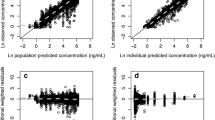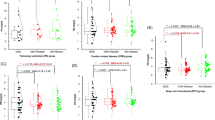Abstract
The population pharmacokinetics of racemic warfarin was evaluated using 613 measured warfarin plasma concentrations from 32 adult hospitalized patients and 131 adult outpatients. Warfarin concentrations were measured in duplicate using a high-performance liquid chromatographic procedure. The pharmacokinetic model used was a one-compartment open model with first-order absorption (absorption rate constant set equal to 47 day−1) and first-order elimination. The extent of availability was assumed to be one. A linear regression model was used to evaluate the influence of various demographic factors on warfarin oral clearance. Age appeared to be an important determinant of warfarin clearance in this adult population. There was about a 1%/year decrease in oral clearance over the age range of 20–70 years. Smoking appeared to result in a 10% increase in warfarin clearance, while coadministration of the inducers phenytoin or phenobarbital yielded about a 30% increase in clearance. This study has yielded a predictive model that, when combined with appropriate pharmacological response data, may be useful in the design and adjustment of warfarin regimens.
Similar content being viewed by others
References
K. Pyorala. Determinants of clotting factor response to warfarin in the rat.Ann. Med. Exp. Biol., Fenn 43:1–98 (1965).
B. B. Brodie, J. J. Burns, and M. Weiner. Metabolism of drugs in subjects with laemnecs cirrhosis.Med. Esp. 1:290–292 (1959).
P. Ristola and K. Pyorala. Determinants of the response to coumarin anticoagulants in patients with acute mycardial infarction.Acta Med. Scand. 192:183–188 (1972).
Y. Y. Wong, D. R. Mungall, T. McLemore, M. M. Montiel, and T. M. Ludden, Overanticoagulation associated with severe heart failure: A case report. InProceedings of the ASHP Midyear Clinical Meeting, Los Angeles, California, December 7, 1982.
D. Lawson and E. D. Lowe. Clinical use of anticoagulant drugs.Am. J. Hosp. Pharm. 34:1225–1234 (1977).
R. A. O'Reilly and P. M. Aggeler. Determinants of the response to oral anticoagulant drugs in man.Pharmacol. Rev. 22:35–93 (1970).
L. B. Sheiner, B. Rosenberg, and K. C. Melmon. Modelling of individual pharmacokinetics for computer-aided drug dosage.Comput. Biomed. Res. 5:441–449 (1972).
L. B. Sheiner, B. Rosenberg, and V. V. Marathe. Estimation of population characteristics of pharmacokinetic parameters from routine clinical data.J. Pharmacokin. Biopharm. 5: 445–479 (1977).
S. Beal and L. B. Sheiner. Estimating population kinetics.CRC Crit. Rev. Biomed. Eng. 8:195–222 (1982).
D. Mungall, Y. Y. Wong, R. L. Talbert, M. H. Crawford, J. Marshall, D. W. Hawkins, and T. M. Ludden. Plasma protein binding of warfarin: Methodologic considerations.J. Pharm. Sci. 73, 1000–1001 (1984).
M. J. Fasco, L. J. Piper, and L. S. Kaminsky. Biochemical applications of a quantitative high-pressure liquid chromatographic assay of warfarin and its metabolites.J. Chromatogr. 131:365–373 (1977).
T. H. Grasela, L. B. Sheiner, B. Rambeck, H. E. Boenigk, A. Dunlop, P. W. Mullen, J. Wadsworth, A. Richens, T. Ishizaki, K. Chiba, H. Miura, K. Mingagawa, P. A. Blain, J. C. Mucklow, C. T. Bacon, and M. Rawlins. Steady-state pharmacokinetics of phenytoin from routinely collected patient data.Clin. Pharmacokin. 8:355–364 (1983).
J. G. Wagner, B. G. Welling, K. D. Lee, and J. E. Walker.In vivo andin vitro availability of commercial warfarin tablets.J. Pharm. Sci. 60:666–677 (1971).
M. L. Hyneck, M. H. Johnson, J. G. Wagner, and G. W. Williams. Comparison of methods for estimating digoxin dosing regimens.Am. J. Hosp. Pharm. 38:69–73 (1981).
A. M. M. Shepherd, D. S. Hewick, T. A. Moreland, and I. H. Stevenson. Age as a determinant of sensitivity to warfarin.Br. J. Clin. Pharm. 4:315–320 (1977).
P. A. Routledge, P. H. Chapman, P. M. Davie, and M. D. Rawlins. Pharmacokinetics and pharmacodynamics of warfarin at steady-state.Br. J. Clin. Pharmacol. 8:243–247 (1979).
K. Hotraphingo, E. J. Triggs, B. Maybloom, and A. Maclaine-Cross. Warfarin sodium: Steady-state plasma levels and patient age.Clin. Exp. Pharmacol. Physiol. 5:143–149 (1978).
P. A. Routledge, P. H. Chapman, D. M. Davies, and M. D. Rawlins. Factors affecting wafarin requirements: A prospective population study.Eur. J. Clin. Pharmacol. 15:319–322 (1979).
S. Husted and F. Andreasen. The influence of age on the response to anticoagulants.Br. J. Clin. Pharmacol. 4:559–565 (1977).
A. A. Mitchell. Smoking and warfarin dosage (letter).N. Engt J. Med. 287:1153–1154 (1972).
K. Bachman, R. Shapiro, R. Fulton, F. T. Carrol, and T. J. Sullivan. Smoking and warfarin disposition.Clin. Pharmacol. Ther. 25:309–315 (1978).
A. Breckenridge and M. Orme. Clinical implications of enzyme induction.Ann. N. Y. Acad. Sci. 179:421–431 (1971).
M. B. Kristensen. Drug interactions and clinical pharmacokinetics. In: M. Gibaldi and L. Prescott (eds.),Handbook of Clinical Pharmacokinetics, Adis Health Science Press, New York, 1983, pp. 242–284.
K. O'Malley, I. H. Stevenson, C. A. Ward, A. J. Wood, and J. Crooks. Determinants of anticoagulant control in patients receiving warfarin.Br. J. Clin. Pharmacol. 4:309–314 (1977).
S. L. Beal. Population pharmacokinetic data and parameter estimation based on their first two statistical moments.Drug Metab. Rev. 15:173–193 (1984).
J. Svec, R. Coleman, D. Mungall, and T. M. Ludden. Bayesian pharmacokinetic/pharmacodynamic forecasting of prothrombin response to warfarin therapy.Drug Intell Clin. Pharm. 18:513 (1984).
L. B. Sheiner and S. L. Beal. Bayesian individualiation of pharamacokinetics: Simple implementation and comparison with non-Bayesian methods.J. Pharm. Sci. 71:1344–1348 (1982).
Author information
Authors and Affiliations
Rights and permissions
About this article
Cite this article
Mungall, D.R., Ludden, T.M., Marshall, J. et al. Population pharmacokinetics of racemic warfarin in adult patients. Journal of Pharmacokinetics and Biopharmaceutics 13, 213–227 (1985). https://doi.org/10.1007/BF01065653
Received:
Revised:
Published:
Issue Date:
DOI: https://doi.org/10.1007/BF01065653




